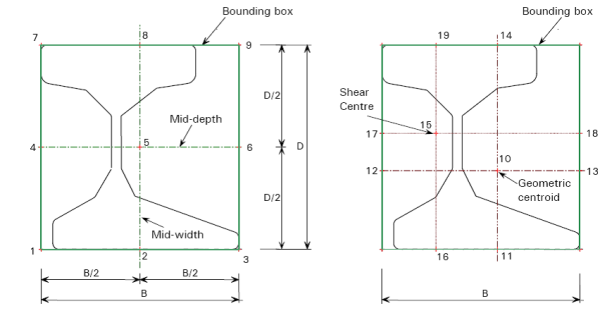Cardinal Points
Overview
A detailing layer is available in RISA-3D that lets you set the "true" elevations and locations start/end, top of steel, etc...) for all members. For each member you can describe the connection point at member ends.
The areas where member detailing parameters can be added/viewed are:
- RISA-3D
- Drawing members
 Properties panel
Properties panel  Detailing Properties
Detailing Properties - Click member
 Properties panel
Properties panel  Detailing Properties
Detailing Properties - Data Entry toolbar
 Members spreadsheet
Members spreadsheet  Detailing tab
Detailing tab - View tab
 Model View Settings button
Model View Settings button  Members tab
Members tab  Detailing Info
Detailing Info
- Drawing members
 Application Settings button
Application Settings button  General tab.
General tab.For each end of the member, both cardinal point positions and decimal local offsets are used to described the connection location. The location of the cardinal point is plotted as follows:
Cardinal point Location and Local Axis
Click on image to enlarge it
| Cardinal point 1:lower left corner of the member section bounding box |
| Cardinal point 2:lower center point in the member section bounding box |
| Cardinal point 3:lower right corner of the member section bounding box |
| Cardinal point 4:mid-depth left point in the member section bounding box |
| Cardinal point 5:mid-depth center point in the member section bounding box |
| Cardinal point 6:mid-depth right point in the member section bounding box |
| Cardinal point 7:upper left corner of the member section bounding box |
| Cardinal point 8:upper center point in the member section bounding box |
| Cardinal point 9:upper right corner of the member section bounding box |
| Cardinal point 10:Geometric centroid of the member section |
The x, y, and z offsets are based on the local axis of the member. The x local axis is defined along the member from I to J. It coincides with the geometric centroid of the member section. The standard cardinal point positions (1-10), as well as the decimal local offsets are both supported in current detailing definition. If the cardinal point is set, the y and z offset values are automatically calculated and filled in the data structure. If there is a situation that doesn't match a cardinal point (angle brace as an example) you can also set the y and z offsets directly.
Detailing Input and Modification
There are two ways for setting and modifying the detailing layer information. You can use the Properties panel or the Members spreadsheet to set the detailing information.
Default
When a member is drawn, by default, x offsets are set to be 0 on both ends. If the member type is beam , by default the y and z detailing offsets are on cardinal point 8 ( top center) for both ends. If the member type is column, by default the detailing offset are on cardinal point 10 for both ends.
Properties panel
When drawing or modifying a member, the Detailing Properties section in the Properties panel contain member detailing information. You can choose to “set y, z offset using cardinal point” or “set y, z offsets directly”. When a cardinal point is picked, the value in the “y Offset” and “z Offset” text box are automatically updated.
Spreadsheets
A detailing tab is available on the Members spreadsheet. The spreadsheet shows a label and 8 values for each member. The “I cardinal point” and “J Cardinal Point” are dropdown lists with numbers and a description. When you pick a cardinal point, the y and z offset values update automatically based on the current shape. When a new y and z offset are input by you and it doesn’t fall on any cardinal point, the “Cardinal Point” automatically changes to “None”.
Visualization of the Detailing Layer
File I/O
[.MEMBERS_DETAILING_DATA] data section is added to the .R3D file to hold the member true location data. [..RF_COLUMNS_DETAILING_DATA] and [..RF_BEAMS_DETAILING_DATA] data sections are added to the .RFL file to hold member true location data. The CIS2 translator is updated to read/write this new data section.
